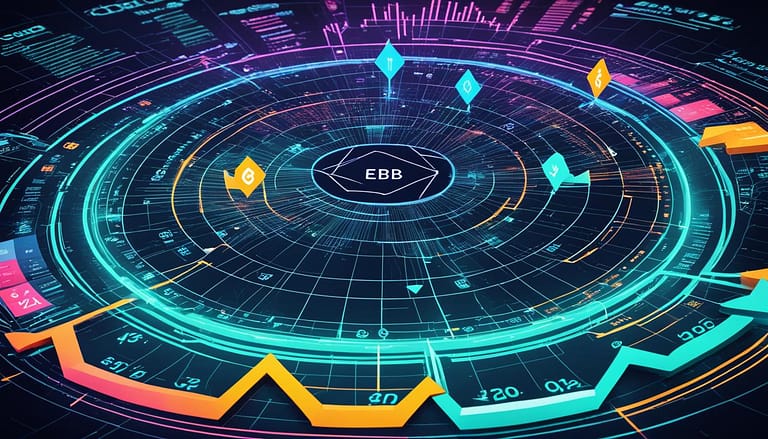Exploring Investment Opportunities in Decentralized Finance (DeFi)
The financial paradigm is witnessing a transformative era with the rise of the DeFi ecosystem—a landscape teeming with unprecedented investment opportunities. DeFi has established itself as a robust alternative to traditional finance, leveraging blockchain technology to facilitate an open, accessible, and diversified financial terrain. For savvy investors in Canada and beyond, the DeFi ecosystem is no longer just a niche market but a burgeoning field ripe with DeFi opportunities that promise not only variety but also the potential for significant returns.
Granted, with the alluring prospects of yield farming and token staking come the requirements for due diligence and an understanding of the risks inherent in such a dynamic environment. Nonetheless, Canadians are uniquely positioned to harness the full potential of these investment opportunities—provided they navigate with insight and prudence in the realm of DeFi.
Key Takeaways
- DeFi is revolutionizing the availability of investment opportunities outside traditional financial systems.
- The DeFi ecosystem offers distinct ventures such as yield farming and token staking.
- Engaging with the DeFi market requires a blend of vigilance and strategic acumen.
- Canadians have the opportunity to be at the forefront of adopting DeFi opportunities.
- Investment in DeFi comes with high potential returns, balanced by an understanding of associated risks.
- Proper research and risk management are keys to capitalizing on DeFi’s potential.
The Rise of Decentralized Finance
The landscape of finance is undergoing a revolutionary shift with the DeFi growth, leveraging the robust blockchain technology to empower individuals with unprecedented access to a full spectrum of financial services. This evolution paves the way for generating passive income in DeFi, an opportunity that’s swiftly capturing the interest of savvy investors around the globe.
At the heart of DeFi’s meteoric rise is the ethos of a community-driven ecosystem – a stark departure from the traditional financial systems with their gatekeeping intermediaries. Instead, DeFi’s intrinsic peer-to-peer protocols champion a more accessible economic model for everyone with the simple requirement of an internet connection.
DeFi’s core lies in its trust in code rather than in institutions, with smart contracts ensuring the security and efficacy of transactions without the classic intermediaries.
These automated contracts run on blockchain networks like Ethereum, guaranteeing that terms are executed to the letter once predetermined conditions are met. It’s a seismic shift in trust from fallible human gatekeepers to immutable code.
Inciting greater interest are applications such as decentralized exchanges (DEXs), and platforms that let users lend and borrow, all created within the secure and transparent confines of decentralized networks. The DeFi ecosystem has, therefore, not just become a hub for financial innovation but stands as a beacon for financial inclusivity and empowerment.
Significantly, the allure of DeFi extends beyond the technological marvels of blockchain. It offers real-world applications where the average person can engage with financial markets, earn passive income, and partake in governance through mechanisms previously beyond their reach.
- Decentralized Exchanges for direct peer-to-peer asset trading
- Yield farming as a route to passive income streams
- Borrowing and lending platforms for improved capital utilization
- Governance participation in protocol directions and upgrades
These tools not only enhance personal wealth but also contribute to a collective financial stability, provided by distributed administrations and smart contract-based assurances. Indeed, DeFi is redefining the financial world, one block at a time.
Understanding the DeFi Ecosystem
The DeFi ecosystem is an intricate tapestry of blockchain networks, smart contracts, and user-oriented services. It’s a testament to the power of decentralized applications and the innovative technologies that sustain them, crafting a new paradigm in finance that’s both accessible and robust. Let’s delve into the key components and mechanisms that constitute this dynamic financial landscape.
Essential Components and Infrastructures
DeFi infrastructure forms the backbone of decentralized finance, enabling a myriad of financial activities without traditional banking systems. At the heart of this infrastructure are blockchain networks, like Ethereum, which provide the immutable ledger for DeFi applications to operate on with full transparency and security. It is here where cryptography comes into play, ensuring secure transactions across the globe.
Decentralized applications (DApps) stand as the user interfaces of DeFi, allowing individuals to engage with DeFi services directly. These applications rely on blockchain protocols that standardize the creation of services, ranging from peer-to-peer trading to automated asset management. The result is a seamless fusion of technology and finance, promoting unparalleled accessibility and efficiency.
How Smart Contracts Power DeFi
Smart contracts are quite literally the ‘smart’ agents within DeFi—self-executing contracts with the terms of the agreement directly written into lines of code. They facilitate automated transactions, minimizing the need for intermediaries and thereby enhancing the efficiency and security of financial interactions on blockchain networks. This automation extends to various DeFi applications, allowing them to operate continuously and autonomously, based on predetermined conditions and consensus protocols.
The Role of Decentralized Exchanges (DEXs)
Decentralized exchanges (DEXs) are integral to DeFi, providing platforms for free and open marketplaces where users can engage in peer-to-peer trading. DEXs operate without the need for a central authority, using smart contracts to facilitate transactions and ensuring a level of privacy and security not found in traditional exchanges. These platforms allow for the creation of liquidity pools, where liquidity providers can earn transaction fees for contributing to the market’s depth and stability.
The table below contrasts elements between decentralized and centralized exchanges, highlighting the inherent benefits of using a DEX within the DeFi ecosystem.
| Feature | Decentralized Exchange (DEX) | Centralized Exchange (CEX) |
|---|---|---|
| Control of Funds | User retains full control | Controlled by the exchange |
| Security | Enhanced by blockchain technology | Dependent on exchange’s security measures |
| Privacy | No personal information required for trading | Personal information often required |
| Trading Fees | Generally lower, with earnings for liquidity providers | Fixed fees, primarily benefiting the exchange |
| Market Manipulation | Reduced possibility due to decentralized nature | Higher risk of manipulation and front running |
As we observe this comprehensive breakdown, it’s evident that decentralized exchanges are at the vanguard of the DeFi movement, empowering individuals with the liberty and security to trade digital assets in an open and transparent environment.
Strategies for Investing in DeFi
The landscape of decentralized finance (DeFi) offers a vast array of DeFi investment strategies for those ready to immerse themselves in this innovative sector. Among the plethora of options, purchasing tokens from established DeFi protocols such as Uniswap or Aave stands out as a straightforward approach to take part in the burgeoning space.
Diversification within DeFi is also achievable via index tokens, of which the DeFi Pulse Index is a quintessential example. Providing exposure to a spectrum of assets within the ecosystem, such indices offer investors a broad-market approach. Adding depth to the investment palette, platforms like Compound Finance invite individuals to partake in liquidity provision, thus earning interest through a peer-to-peer mechanism central to the essence of DeFi.
Beyond the traditional buy-and-hold tactic, yield farming invites investors to deposit their tokens into liquidity pools, where rewards, often in the form of additional tokens, are harvested. To illustrate, PancakeSwap rewards participants with its native CAKE tokens for liquidity provision, solidifying yield farming’s role as a lucrative engine in the DeFi domain.
Here’s a comparative look at various DeFi investment strategies:
| Strategy | Potential Returns | Associated Risks | Suitability |
|---|---|---|---|
| Token Purchases (e.g., Uniswap, Aave) | Varies with protocol performance | Market volatility, Smart contract vulnerabilities | Beginners to Advanced |
| DeFi Index Tokens (e.g., DeFi Pulse Index) | Diverse market exposure | Spread risk, Lower rewards for individual token spikes | Investors seeking diversified exposure |
| Liquidity Provision (e.g., Compound Finance) | Interest earnings, Liquidity provider rewards | Impermanent loss, Liquidity crunch | Intermediate to Advanced involved in lending/borrowing |
| Yield Farming (e.g., PancakeSwap) | High reward potential in form of additional tokens | Market volatility, Impermanent loss, Smart contract risks | Advanced with risk appetite |
Investing in DeFi requires a careful balancing act between exploring these strategies and understanding each’s intricacies. Those looking to step into the promising yet complex world of DeFi should make judicious choices, backed by comprehensive research and risk assessment.
Prospects of Yield Farming in DeFi
Yield farming has taken center stage in the decentralized finance realm, offering significant DeFi earnings and passive income opportunities. Through its innovative strategies, investors contribute tokens to protocols, with potentially high rewards that enhance their yield farming prospects. Let’s delve into how the cornucopia of yield farming avenues can lead to different income streams but also require a prudent approach to handle the associated risks.
Liquidity Provision: Among the most prevalent methods in yield farming, investors provide their assets to create liquidity pools. This essential part of the Automated Market Maker (AMM) model allows exchanges to facilitate trades and in return, liquidity providers earn a percentage of the transaction fees.
- Evaluating Returns: A crucial step is to observe the potential returns from various pools, as they differ based on the pair’s trading volume and protocol incentives.
- Assessing Risks: While the rewards can be high, one must assess the risks such as impermanent loss, which occurs when the price of deposited assets changes compared to when they were deposited.
Staking: This involves locking up tokens in a smart contract to earn rewards or interest. Platforms reward participation, enhancing security, or contributing to the governance process.
- It often requires minimal effort after the initial setup, turning it into an attractive option for passive income.
- Even though staking is typically less risky than other yield farming methods, it’s not without its potential pitfalls, like the lock-up period during which one cannot access their funds.
| DeFi Platform | Annual Percentage Yield (APY) | Rewards Type | Liquidity Risk Level |
|---|---|---|---|
| Uniswap | 15% | Transaction fees + UNI tokens | Medium |
| Compound | 4.5% | Interest + COMP tokens | Low |
| Curve Finance | 10% | Transaction fees + CRV tokens | High |
When considering the yield farming prospects, one cannot ignore the imperative of due diligence. The fluctuating nature of DeFi earnings calls for a sound risk assessment strategy and continuous monitoring of the market to optimize yield farming outcomes. As investors seek passive income streams through DeFi, recognizing and navigating through the volatile waters of yield farming can be vital for success.
Decentralized Finance
The emergence of Decentralized Finance (DeFi) has brought about a stark contrast to the established norms of traditional finance. By leveraging blockchain technology, DeFi introduces a novel financial landscape that is autonomous and operates on a peer-to-peer model. This financial revolution not only challenges the status quo but also ushers in a wealth of decentralized finance benefits that advocates for consumer empowerment and system transparency.
Comparing DeFi to Traditional Financial Systems
When juxtaposing DeFi vs traditional finance, the differences are profound and multifaceted. Traditional banking and financial systems have long been characterized by their hierarchical structures and intermediaries. DeFi, on the other hand, defies these conventions by expediting direct transactions and offering a more inclusive financial environment. Central to its ethos, the peer-to-peer finance framework inherent in DeFi circumvents the layers of bureaucracy that slow down and complicate conventional monetary exchanges.
Transparency and Autonomy in Financial Transactions
At the heart of DeFi is the philosophy of financial transparency and DeFi autonomy. In stark contrast to the opacity that often shrouds traditional financial transactions, each exchange within the DeFi space is open to scrutiny and verifiable via the blockchain ledger. This openness allows participants to transact with confidence, as every operation is both transparent and immutable. The benefits extend beyond mere clarity; they offer participants unprecedented control over their financial dealings, advancing a new era of financial self-sovereignty.
| Feature | Traditional Finance | Decentralized Finance (DeFi) |
|---|---|---|
| Intermediaries | Banks and Financial Institutions | Smart Contracts |
| Transaction Model | Peer-to-Institution | Peer-to-Peer (P2P) |
| Accessibility | Dependent on Institutional Approval | Open to Anyone with Internet Access |
| Transparency | Limited Public Scrutiny | Fully Transparent and Auditable |
| Control Over Assets | Institutional Custody | User Retains Full Control |
These distinctions manifest a pivotal shift towards a financial ecosystem that is not only more inclusive but intrinsically progressive. As we witness the continued ascendancy of DeFi, backed by its profound principles of autonomy and transparency, the financial domain stands at the cusp of a transformative epoch.
Lending and Borrowing in the DeFi Space
The innovative landscape of DeFi lending upends the conventions of traditional finance systems by embracing accessibility and efficiency. In a stark contrast to traditional banking, peer-to-peer lending in the DeFi ecosystem relies on transparent, automated protocols handled by smart contracts, removing barriers and streamlining the exchange between lender and borrower. This digitalization of finance ensures that everyone, regardless of geographic location or financial status, can access crypto borrowing solutions with ease.
Platforms like Compound Finance have pioneered automated systems dedicated to the protection and benefit of both parties involved in the lending equation. As such, lenders can potentially accrue interest on their digital assets and perhaps even earn extra rewards in the form of native tokens to the protocol they’re using.
By eliminating intermediaries, DeFi has veritably transformed the notion of borrowing, extending its reach beyond the confining parameters set by traditional financial institutions. It’s a more democratic approach to lending that’s aligned with the current digital direction of modern society.”
Below is a comparative analysis of the various features offered by prominent DeFi platforms, specifically focusing on lending and borrowing.
| Platform | Interest Rates (APR) | Lender Rewards | Borrowing Options |
|---|---|---|---|
| Compound Finance | Varies with Market | COMP Tokens | Crypto-secured Loans |
| Aave | Varies with Market | Staking | Flash Loans |
| MakerDAO | Stability Fee | DAI Savings Rate | Collateralized Debt Positions |
DeFi’s inherent adaptability to market dynamics serves as a robust foundation for emerging financial activities. It’s a testament to the progressive scalability of DeFi lending and crypto borrowing opportunities, shaping the very definition of modern finance.
The Evolution of DeFi Platforms
The evolution of DeFi has been nothing short of revolutionary, marking a significant shift in the financial innovation landscape. DeFi has reimagined the realms of loans, savings, and trading by leveraging the inherent benefits of blockchain technology. The DeFi platform development journey has systematically dismantled barriers to finance, opening an avenue for inclusive financial services that are accessible globally.
Traditional financial services have long been guarded by institutions that dictate terms and require intermediaries for operations. DeFi, on the other hand, creates an open-market architecture where services are decentralized and transactions are transparent. Through the use of smart contracts and decentralized applications (DApps), DeFi platforms have integrated the principles of blockchain to deliver autonomous and interoperable financial tools.
“DeFi is not just a shift in finance; it’s a revolution of the economic structures and possibilities, redefining access and control over personal finances.”
In order to understand the scale and potentiality of this financial upheaval, the following table compares the attributes of DeFi platforms over time, illustrating the transformation within this dynamic sector:
| Attribute | Early Development | Current Trends | Future Prospects |
|---|---|---|---|
| Accessibility | Limited user interface, early adopters | User-friendly applications, broader audience | Universal access with integrated services |
| Services Offered | Basic lending and borrowing | Complex financial instruments like derivatives | Holistic banking alternatives |
| Technological Use | Basic smart contracts | Advanced smart contracts, DAOs | AI-integrated smart contracts, enhanced DAO governance |
| Market Capitalization | Emerging market with limited capital | Billions in locked value | Expected exponential growth |
The table underscores the robust momentum of DeFi platform development, reflecting not only a quantitative growth in terms of market capitalization but also qualitative improvements in accessibility and the range of services offered. DeFi has engineered a paradigm where community governance and algorithmic finance enable a more democratized financial ecosystem.
The agile nature of DeFi has facilitated a continuous cycle of innovation, as platforms evolve to accommodate an ever-growing suite of financial products and services. Thus, the future of DeFi isn’t just an extension of its current state; it’s a beacon for uncharted economic territories that invite invention, creativity, and inclusive prosperity.
Decentralized Finance Tokens: A Gateway to DeFi Investment
The rapidly expanding world of Decentralized Finance (DeFi) presents a wealth of investment opportunities through its myriad of DeFi tokens. Diverse in their utility and functionality, these tokens are not just digital assets; they are the investment gateway to innovative financial services within the DeFi ecosystem. Amongst the most influential of these are governance tokens, which grant investors the right to contribute to a protocol’s decision-making process, embodying the decentralized and democratic ethos of DeFi.
Utility tokens and liquidity provider tokens are two other primary categories that make up the DeFi token spectrum, each offering unique roles and investment prospects. While utility tokens unlock access to specific functions within the DeFi platforms, liquidity provider tokens are instrumental in yield farming, underpinning the very concept of earning returns through liquidity provision.
Recognizing the significance of DeFi tokens in the contemporary financial landscape is paramount for any investor looking to navigate through the burgeoning DeFi space.
In order to illustrate the varied nature of DeFi tokens and their potential for investors, the following table categorizes some of the most prevalent types of tokens within DeFi, underscoring the multifaceted opportunities at hand:
| Type of Token | Function | Opportunity for Investors |
|---|---|---|
| Governance Tokens | Allows holders to participate in platform governance | Vote on proposals, shape protocol, potential appreciation |
| Utility Tokens | Provide access to DeFi platform services | Engage with platform-specific features, potential service discounts |
| Liquidity Provider Tokens | Represent a stake in a liquidity pool | Earn transaction fees, yield farming rewards |
It’s imperative for investors to conduct diligent research into the specifics of each token type, understanding their role within the DeFi infrastructure and the risks associated with them. With informed decisions and strategic investments, DeFi tokens not only offer a new avenue for financial growth but also allow investors to partake in the forward-thinking movement of decentralization that is reshaping the finance industry.
Overcoming Challenges and Risks in DeFi Investments
The burgeoning DeFi ecosystem has revolutionized finance, offering an array of rich investment possibilities. However, engaging with this digital frontier necessitates a deep understanding of the risks involved and the implementation of comprehensive risk mitigation strategies to safeguard one’s investments.
Security Considerations and Smart Contract Audits
DeFi security should be a priority for any investor venturing into this domain. The decentralized nature of DeFi, while eliminating intermediaries, also removes traditional safety nets. Consequently, the onus for security falls on the investor. Smart contract audits are indispensable tools in the risk mitigation toolkit. Rigorous audits help to uncover and rectify vulnerabilities before malicious actors can exploit them, thereby fortifying the bedrock of the DeFi infrastructure.
To illustrate the essential nature of these audits, below is a comparative table showcasing common points of failure in non-audited versus audited smart contracts:
| Non-Audited Smart Contracts | Audited Smart Contracts |
|---|---|
| Potentially undiscovered coding flaws | Code scrutinized for security weaknesses |
| Higher susceptibility to security breaches | Reduced risk of breaches after rectification of vulnerabilities |
| Lack of investor confidence | Increased trust from investors |
| Increased likelihood of financial loss | Enhanced protection against financial exploits |
Dealing With Market Volatility and Liquidity Issues
Investors swimming in the DeFi liquidity pools must contend with the tumultuous waters of market volatility. The prices of cryptocurrencies can surge or plummet with little warning, driven by a myriad of factors, from global economic trends to regulatory updates. Managing investment risks in such a volatile environment demands due diligence and an agile investment strategy. Diversification across different assets and platforms can help absorb shocks from market swings.
Effective navigation through the DeFi space involves not only preparing for volatility but also understanding the intricacies of DeFi liquidity. Liquidity, the lifeblood of DeFi protocols, can sometimes dry up unexpectedly, leading to market slippage and affecting trade execution. Meticulous liquidity analysis and an active management approach are indispensable for mitigating such investment risks.
Maintaining a balanced perspective and a comprehensive approach towards risk mitigation are critical. Through due diligence, investors can position themselves with a defensive stance against the uncertainties of the DeFi landscape.
Conclusion
The decentralized finance (DeFi) sector presents a transformative panorama for both seasoned and novice participants in the investment world. With a landscape teeming with DeFi market insights, enthusiasts are embracing a future rich with possibilities for financial empowerment and inclusion. Through DeFi, barriers that once confined many to the sidelines of finance are systematically being dismantled, enabling a more inclusive financial ecosystem.
This innovative space demands strategic investment approaches, asking investors to not only focus on potential gains but also to engage with due diligence in understanding the technologies and platforms they back. The prospects that DeFi heralds are not without their challenges—as with any fledgling market, volatility and security are considerations that necessitate a keen and informed strategy. However, navigating these challenges can lead to rewarding opportunities for those prepared to invest the time and effort into their DeFi journey.
Indeed, as DeFi continues to grow and evolve, it underscores the importance of staying abreast of developments within the ecosystem, prioritizing robust security measures, and partaking in the governance processes that will shape the future of decentralized finance. The empowered investor is one who seizes the innovative prospects of DeFi, crafting a narrative of personal and collective financial success within this dynamic domain.










